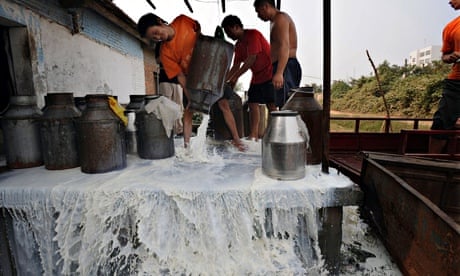China is growing thirsty for milk: a Chinese consumer drinks around 10kg of liquid milk a year these days, up from 1kg in 2000.
China's sudden taste for milk has seen its dairy industry double in value over the past five years to an estimated $40.6bn (£24.3bn), leading to talk of a "white gold rush". The market calculation comes from China Mengniu Dairy, one of the country's largest milk producers – and the object of a recent $665m investment by Danone, a French food company.
"More and more people are starting to drink milk and eat dairy products such as cheese, which was never really the case before," says Dinghuan Hu, a professor in agricultural economics at the Chinese Academy of Agricultural Services.
Though he welcomes the nutritional benefits of increased dairy consumption, Dinghuan says China would like to industrialise dairy production to meet domestic demand and the shift to larger, more concentrated farms could have serious environmental and food safety implications.
The signs of a huge scale-up in production are already visible. China has more than 40 farms with herds of more than 10,000 cows, local media reports suggest, and imports are escalating. Between 2009 and 2012, Chinese farmers shipped in around 250,000 heifers from New Zealand, Australia and Uruguay.
"You can buy the cows and you can build large farms, but in China people have not mastered the experience to manage herds of 10,000 cows," Dinghuan says. "In the Netherlands, the average herd size is around 80 cows, and that's after more than 100 years of step-by-step increase in technology, farm management and dairy production."
The shift towards mega-farms is actively supported by the Chinese government, which sees it as a mechanism not only for increasing production but also standardising product quality. The policy emerged after the 2008 melamine scandal, when tens of thousands of Chinese babies fell sick after drinking adulterated infant formula.
Trust in Chinese powdered milk products remains low, with many consumers preferring to pay a premium for foreign brands. That is good news for international companies such as Mead Johnson, Danone Dumex and Nestle's Wyeth and Abbott, which between them control two-fifths of China's lucrative infant formula market. But it bodes less well for small domestic producers, many of whom are going out of business as costs increase and subsidies dry up.
A shift to large-scale farming without the requisite know-how could pose animal welfare risks. Rates of brucellosis, mastitis and other diseases associated with industrialised factory farming are already on the rise in Chinese herds, according to Shefali Sharma, a senior adviser at the US-based Institute of Agriculture and Trade Policy and co-author of a recent report, China's Dairy Dilemma.
Environmental pollution is also a concern. A recent academic study of dairy farms in the south of China, for example, found many types of antibiotics in field soil, well water and streams. "The [Chinese] government, especially the environment ministry, is concerned about what is happening, but I don't think there is a consensus about what to do," says Sharma.
One option might be to look at best practice in the international dairy industry. Back in 2009, six leading dairy associations – including the European Dairy Association, the Global Dairy Platform and the International Dairy Federation – initiated a programme to reduce the environmental footprint of milk production.
The Global Dairy Agenda for Action (GDAA) was established on the heels of a report by the UN-backed Food and Agriculture Organisation, which found that the livestock industry as a whole was responsible for 18% of global greenhouse gas emissions – worse than all the world's cars and trucks put together.
Five years on, the GDAA is collating a growing repository of management tools and sustainability case studies on which farmers can draw. "This stuff is completely pre-competitive", says Erin Fitzgerald, senior vice president for sustainability at the industry-funded Innovation Centre for US Dairy. To date, however, the industry's big players are yet to develop a large-scale certification system that can reassure consumers of sustainability standards in the dairy supply chain.
"[Sustainable dairy production] is complex. It requires the best scientists, businessmen and farmers … but we need to make sure that farmers all over the world implement best practice," she adds.
To that end, FrieslandCampina, a Dutch farming cooperative representing over 14,000 dairy farms, is running a technical training programme for farmers in Asia and Africa. The Dairy Development Programme offers practical advice on everything from good feeding and fertility practices to energy efficiency and water management.
Sybren Attema, the programme's regional manager in Vietnam, concedes that mechanisation can improve the overall productivity and health of dairy cows. Yet he is cautious about industrial-scale farms, arguing that small-scale farming has lower impacts and generates greater developmental benefits.
"We believe you [should] create family dairy businesses in rural areas because they spend their money locally," says Attema, who emphasises the consequent benefits for local feed producers, equipment suppliers, veterinarians and so on. "That's much better than concentrating industrial farms in one place, which does not increase economic activity."
The supply chain hub is funded by the Fairtrade Foundation. All content is editorially independent except for pieces labelled as advertising features. Find out more here.
Join the community of sustainability professionals and experts. Become a GSB member to get more stories like this direct to your inbox.

Comments (…)
Sign in or create your Guardian account to join the discussion